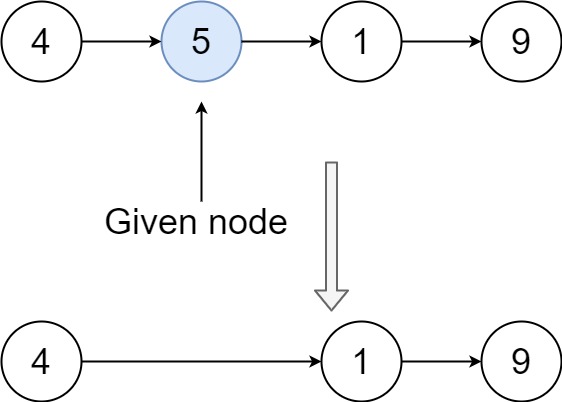原文链接: https://leetcode-cn.com/problems/delete-node-in-a-linked-list
英文原文
Write a function to delete a node in a singly-linked list. You will not be given access to the head of the list, instead you will be given access to the node to be deleted directly.
It is guaranteed that the node to be deleted is not a tail node in the list.
Example 1:

Input: head = [4,5,1,9], node = 5 Output: [4,1,9] Explanation: You are given the second node with value 5, the linked list should become 4 -> 1 -> 9 after calling your function.
Example 2:

Input: head = [4,5,1,9], node = 1 Output: [4,5,9] Explanation: You are given the third node with value 1, the linked list should become 4 -> 5 -> 9 after calling your function.
Example 3:
Input: head = [1,2,3,4], node = 3 Output: [1,2,4]
Example 4:
Input: head = [0,1], node = 0 Output: [1]
Example 5:
Input: head = [-3,5,-99], node = -3 Output: [5,-99]
Constraints:
- The number of the nodes in the given list is in the range
[2, 1000]. -1000 <= Node.val <= 1000- The value of each node in the list is unique.
- The
nodeto be deleted is in the list and is not a tail node
中文题目
请编写一个函数,用于 删除单链表中某个特定节点 。在设计函数时需要注意,你无法访问链表的头节点 head ,只能直接访问 要被删除的节点 。
题目数据保证需要删除的节点 不是末尾节点 。
示例 1:

输入:head = [4,5,1,9], node = 5 输出:[4,1,9] 解释:指定链表中值为 5 的第二个节点,那么在调用了你的函数之后,该链表应变为 4 -> 1 -> 9
示例 2:

输入:head = [4,5,1,9], node = 1 输出:[4,5,9] 解释:指定链表中值为 1 的第三个节点,那么在调用了你的函数之后,该链表应变为 4 -> 5 -> 9
示例 3:
输入:head = [1,2,3,4], node = 3 输出:[1,2,4]
示例 4:
输入:head = [0,1], node = 0 输出:[1]
示例 5:
输入:head = [-3,5,-99], node = -3 输出:[5,-99]
提示:
- 链表中节点的数目范围是
[2, 1000] -1000 <= Node.val <= 1000- 链表中每个节点的值都是唯一的
- 需要删除的节点
node是 链表中的一个有效节点 ,且 不是末尾节点
通过代码
高赞题解
思路分析
如果我们要在链表中删除一个节点,一般的操作是:
- 修改要删除节点的上一个节点的指针
- 将该指针指向要删除节点的下一个节点
例如,在链表 [4, 5, 1, 9] 中,当我们要删除节点 5 时,我们会修改节点 5 上一个节点 4 的指针,让它指向节点 5 的下一个节点,即节点 1:

但这道题只告诉我们要删除的节点,我们并不知道该节点的上一个节点是什么,这时候又该如何是好呢?
既然我们要删除一个节点时需要知道它的上一个节点,如果我们无法得知上一个节点,我们就 找一个可以知道上一个节点的节点,把它变成要删除的节点,然后删除它。
这样听起来好像有些拗口?没事,直接看一个例子!
还是 [4, 5, 1, 9] 链表,还是删除节点 5。
首先,我们把节点 5 下一个节点的值赋给它,把它变成一个「不需要删除」的节点:

这样一来,第二个节点 1 和第三个节点 1,无论我们删除其中的哪一个,都可以得到最终结果 [4, 1, 9]。既然第二个节点不好删除,那我们就果断删除第三个啦~
改变第二个节点 1 的指针,将它指向第 4 个节点 9,这样一来,第三个节点 1 就被删除了:

具体实现
[]# Definition for singly-linked list. # class ListNode: # def __init__(self, x): # self.val = x # self.next = None class Solution: def deleteNode(self, node): """ :type node: ListNode :rtype: void Do not return anything, modify node in-place instead. """ node.val = node.next.val node.next = node.next.next
[]/** * Definition for singly-linked list. * type ListNode struct { * Val int * Next *ListNode * } */ func deleteNode(node *ListNode) { node.Val = node.Next.Val node.Next = node.Next.Next }
复杂度
- 时间复杂度 $O(1)$
- 空间复杂度 $O(1)$
总结一下
这道题没有给出链表的头节点,而是直接给出要删除的节点,让我们进行原地删除。我们对于该节点的前一个节点一无所知,所以无法直接执行删除操作。因此,我们将要删除节点的 next 节点的值赋值给要删除的节点,转而去删除 next 节点,从而达成目的。
题目中指明了「给定的节点为非末尾节点」且「链表至少包含两个节点」,所以上述方案是切实可行的。
统计信息
| 通过次数 | 提交次数 | AC比率 |
|---|---|---|
| 253300 | 295697 | 85.7% |
提交历史
| 提交时间 | 提交结果 | 执行时间 | 内存消耗 | 语言 |
|---|
相似题目
| 题目 | 难度 |
|---|---|
| 移除链表元素 | 简单 |




